第二语言学习者个体差异因素研究ppt课件
- 格式:ppt
- 大小:800.00 KB
- 文档页数:53



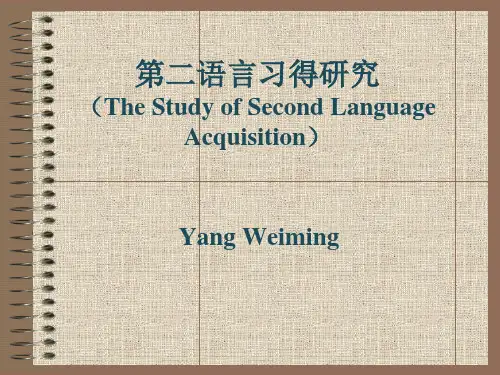
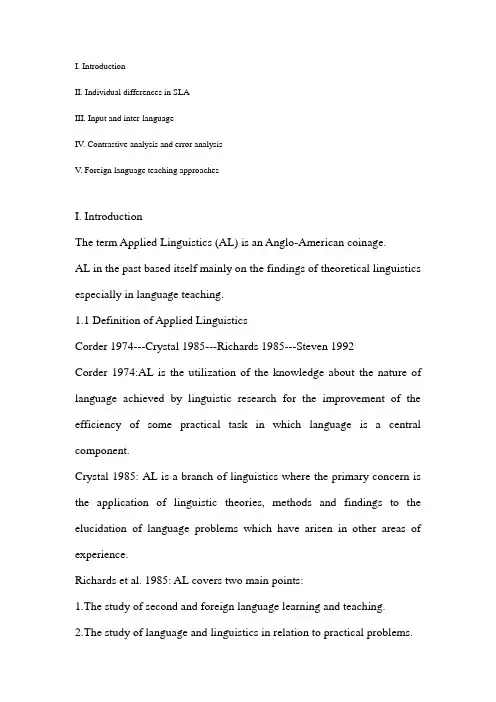
I. IntroductionII. Individual differences in SLAIII. Input and inter-languageIV. Contrastive analysis and error analysisV. Foreign language teaching approachesI. IntroductionThe term Applied Linguistics (AL) is an Anglo-American coinage.AL in the past based itself mainly on the findings of theoretical linguistics especially in language teaching.1.1 Definition of Applied LinguisticsCorder 1974---Crystal 1985---Richards 1985---Steven 1992Corder 1974:AL is the utilization of the knowledge about the nature of language achieved by linguistic research for the improvement of the efficiency of some practical task in which language is a central component.Crystal 1985: AL is a branch of linguistics where the primary concern is the application of linguistic theories, methods and findings to the elucidation of language problems which have arisen in other areas of experience.Richards et al. 1985: AL covers two main points:1.The study of second and foreign language learning and teaching.2.The study of language and linguistics in relation to practical problems.Steven 1992:AL is a multidisciplinary approach to the solution of language-related problems.The problems it attempts to solve include speech pathology, machine translation, national language planning policy, various facets of communication research and many others.HU Zhuang Lin 2004:Applied Linguistics (AL) serves as a mediating area which interprets the results of linguistic theories and makes them user friendly to the language teacher and learner.1.2 EFL and ESL(EFL) ENGLISH AS A FOREIGN LANGUAGE : Learning English in a community that doesn’t speak English.(ESL) ENGLISH AS A SECOND LANGUAGE: Leaning English in a place where it is the spoken language.According to UNESCO, second language is a language acquired/learned by a person in addition to his mother tongue.1.3 Learning and AcquisitionLearning is a deliberate, conscious attempt to master a language, while acquisition is a less deliberate, subconscious process of mastering language.As a L2 learner, you can hardly speak in the same way as a native speaker. Phonologically, morphologically, syntactically, semanticallyand pragmatically, there bound to be some differences.1.4 First and Second Language AcquisitionThink about a baby acquiring his first language.Think about a person acquiring a second language.What similarities and differences are there in the two processes? Second language learning :painstaking unsuccessfulFirst language acquisition: unconscious successfulFeature 1: Commandchildren normally achieve perfect L1 masteryadult L2 learners are unlikely to achieve perfect L2 mastery Feature 2: Successsuccess guaranteed complete success rareFeature 3: Intuitionschildren develop clear intuitions about correctnessL2 learners are often unable to form clear grammaticality judgments (The house is easy to catch fire.)Feature 4: Negative evidencecorrection not found and not necessarycorrection generally helpful or necessaryFeature 5: GoalsTarget language competenceL2 learners are more concerned with fluency than accuracy, as targetlanguage competence is too difficult to achieve.II. Individual differences in SLAIndividual differences: Age, Personality traits, Cognitive style, Learning strategies, Motivation, Language aptitude2.1 Age and Second Language AcquisitionIs it better to learn a second language when one is young or when one is older? Why?Lenneberg (1967) stated that L2 is best learned between age 2 and puberty.Case studyDo we actually find such a critical period for L2 acquisition?What would a critical period for L2 acquisition look like?Do late learners ever attain nativelikeness?Critical period for L2 acquisitionGeometric features”Heightened sensitivity at beginningClear point where offset (decline) beginsFlat period when critical period is overTemporal features”Heightened sensitivity through early childhoodSensitivity bottoms out when full neurocognitive maturity is reached Continued low sensitivity throughout adulthoodTentative conclusionsIs there a sharp cutoff point where sensitivity begins to decline? NO Does sensitivity flatten out in adulthood? NOIs there a significant change in sensitivity when maturation is reached? NOAdvantages to being a younger learnerMore likely to develop a native-like accentLess to learn to be considered proficientMore likely to receive comprehensible inputAdvantages to being an older learnerCan consciously use strategies to aid learningHas knowledge from L1 to draw fromHas greater control over inputGrammatical CompetenceMastery of language code: Lexicon (vocabulary), Word formation rules, Sentence formation rules, Pronunciation rules, Spelling rules Sociolinguistic CompetenceMastery of appropriate language use in different contextsHow to speak to a friendHow to speak to someone in authorityHow to speak socially vs. ProfessionallyDiscourse CompetenceMastery of how to combine meanings and forms to create a text in different modesExamples: Telephone inquiry ,Narrative text, Oral reportStrategic CompetenceMastery of verbal and non-verbal strategies to compensate for breakdowns in communicationExamples: How to ask for help How to rephrase a statement2.2 MotivationThere isn’t much theory that “provides an all-round explanation of what we do and why.”(Dörnyei 2003:1)“Motivation is a multifaceted construct, and the exact nature of the constituent components activated in a particular situation depends greatly on contextual factors.”(Dörnyei 2003:1) Instrumental motivation--- Immediate achievement Go abroad Social responsibility Individual development----Instrumental motivationCultural motivation---Intrinsic interest Go abroad Social responsibility Information medium---Integrative motivation Interest motivationSituational motivation---Learning situation---Situational motivation Metacognitive strategiesA. Centering your learningB. Arranging and planning your learningC. Evaluating your learningAffective strategiesA. Lowering your anxietyB. Encouraging yourselfC. Taking your emotional temperatureSocial strategiesA. Asking questionsB. Cooperating with othersC. Empathizing with othersResearch has demonstrated(1) Learners are actively involved in their learning.(2) Learners use different kinds of strategies(3) Learners have different beliefs about strategy use and learning approaches(3) Several factors have powerful influence on strategy choice/use: motivation, proficiency, years of study,sex, major, if requirementThe good language learner:(1) is guesser, but an accurate guesser!(2) has a strong drive to communicate.(3) is not often inhibited (a risk-taker).(4) focuses on communication, but also attends to form.(5) practices—and creates opportunities to do so.(6) knows what is appropriate.(7) monitors his own and the speech of others.(8) attends to meaning.(9) Actively participates (aloud and silently).III. Input and Inter-language3.1 Input theory by Krashen Interaction theory by Long Output theory by Swain3.2 InterlanguageDefinition of inputQuestion:Could you explain “input”in second language acquisition?Learners' most direct source of information about the target language is the target language itself. When they come into direct contact with the target language, this is referred to as "input." (/wiki)Stephen Krashen (University of Southern California) is an expert in the field of linguistics, specializing in theories of language acquisition and development. Much of his recent research has involved the study of non-English and bilingual language acquisition. During the past 20 years, he has published well over 100 books andarticles and has been invited to deliver over 300 lectures at universities throughout the United States and Canada.3.1 Krashen’s Input HypothesisKrashen's theory of second language acquisition consists of five main hypotheses:1) the Acquisition-Learning hypothesis,2) the Monitor hypothesis,3) the Natural Order hypothesis,4) the Input hypothesis,5) the Affective Filter hypothesis.Input Hypothesis"The best methods are therefore those that supply 'comprehensible input' in low anxiety situations, containing messages that students really want to hear. These methods do not force early production in the second language, but allow students to produce when they are 'ready', recognizing that improvement comes from supplying communicative and comprehensible input, and not from forcing and correcting production."The Input hypothesis is Krashen's attempt to explain how the learner acquires a second language.This hypothesis claims that “humans acquire language in only one way-by understanding messages or by receiving ‘comprehensibleinput’”(Krashen, 1985:2)Comprehensible input: i+1; output plays little role.Comment on Input theoryInfluential: application in SLT, Types of input, Ways of input, Variety of input, Sufficiency of input, Efficiency of input Controversial:How to quantify and qualify the “i”and “1”in “i+1”Ignorance of outputViews diverge greatly as to what kind of input should be provided for language learners.Authentic input, Comprehensible input (Krashen): i+1 Premodified input, Interactively modified inputInput-based teachingDirect method, Natural approach, Total physical response, Communicative approach, Community language learning (CLL) , Suggestopedia, Silent wayLong’s Interaction HypothesisLong's interaction hypothesis proposes that language acquisition is strongly facilitated by the use of the target language in interaction. In particular, the negotiation of meaning has been shown to contribute greatly to the acquisition of vocabulary (Long, 1990).Study: NSs-NNSs, negotiation for meaning---comprehensible inputThe Interaction Hypothesis highlights the role of social interaction in increasing the amount of comprehensible input that students receive. This interaction includes students asking for help when they do not understand input. Perhaps, the collaborative setting in groups and the trust that can grow among groupmates make it more likely that students will have opportunities to repair comprehension breakdowns.Swain’s Output HypothesisMerrill Swain(Ph.D., University of California)She is Professor in the Curriculum, Teaching and Learning department at the Ontario Institute for Studies in Education (OISE) at the University of Toronto. website: http://www.oise.utoronto.ca/mlc/swain.htmThe output hypothesis claims that the act of producing language (speaking or writing) constitutes, under certain circumstances, part of the process of second language learning.It states that while comprehensible input is necessary for L2 learning, learners also need to speak and to write, i. e., produce output, in their L2.Three functions of output in second language learning:1) the noticing/triggering function 发现所想与所能之间的差别2) the hypothesis-testing function 测试语言假设3) the metalinguistic (reflective) function.增加元语言知识没有输出需要的输入不易转化为程序性知识没有输入帮助的输出不利于语言体系的拓展输出-输入结合的教学活动更具有交际的真实性(文秋芳,2008)3.2 InterlanguageThe type of language constructed by second or foreign language learners who are still in the process of learning a language is often referred to as interlanguage.It is often understood as a language system between the target language and the learner’s native language.E.g. data from SWECCLInterlanguage is a dynamic language system, which is constantly moving from the departure level to the native-like level.Can be done in two ways:investigating the psychological, biological or neurological mechanisms involved in the production of interlanguage; investigating the linguistic features of interlanguage.Concerning the linguistic features of interlanguage, the following questions can be asked:Linguistically, how is interlanguage in general different from the target language or the native language?In what way is lower level interlanguage different from higher levelinterlanguage?How is the interlanguage system used to convey meaning?IV. Contrastive Analysis and Error AnalysisWe assume that the student who comes into contact with a foreign language will find some features of it quite easy and others extremely difficult. Those elements that are similar to his native language will be simple for him, and those elements that are different will be difficult. Lado, 1957, 24.1 Contrastive Analysis (1940s ---1960s)Paul Nation is Professor in Applied Linguistics at the School of Linguistics and Applied Language Studies (LALS) at Victoria University of Wellington, New Zealand.“Research shows that the first language has a small but important role to play in communicating meaning and content.”(Paul Nation, in his article, The Role of the First Language in Foreign Language)4.1.1 Definition of Contrastive Analysis (CA)A way of comparing L1 and L2 to determine potential errors for the ultimate purpose of isolating what needs to be learned and what not in a second language learning situation. (Gass & Selinker, 2001:72) An approach to the study of SLA which involves predicting and explaining learner problems based on a comparison of L1 and L2 todetermine similarities and differences”(Saville-Troike, 2006: 34) 4.1.2 Objectives of CAProviding insights into similarities and differences between languages;Explaining and predicting problems in L2 leaningDeveloping course materials for language teaching4.1.3 Contrastive Analysis HypothesisMain assumptions1) L2 learning involves overcoming difficulties in the linguistic systems of the target language;2) The main difficulties in learning a L2 are caused by interference from the L1;3) Contrastive analysis can predict, or at least account for, difficulties in L2 learning, so teaching materials based on contrastive analysis can reduce the effects of interference and difficulties, and facilitate L2 learning.Contrastive Analysis Hypothesis"Where two languages were similar, positive transfer would occur; where they were different, negative transfer, or interference, would result." (Larsen-Freeman & Long 1991: 53)3 versions of the CA hypothesisThe Strong Version: Fries & LadoIt (a priori) claimed that prediction of difficulties in learning L2 could be made based upon a comparison of two languages. This starts with a crosslinguistic analysis and then attempts to predict trouble spots.The Weak Version: Wardhaugh (1970)It (a posteriori) claimed that cross-linguistic comparison could help to explain learner errors. This starts with learner errors and attempts to account for them with cross-grammatical comparisons.The Moderate Version: Oller & ZiahosseinyIt differs from the above two in that it emphasizes the significance of minimal distinctions, which may actually cause the greatest interferences and difficulties.4.1.4 Procedures of CA2 principles of CA as proposed by Halliday:Describe before comparingComparing patterns, not whole languagesSteps:The separate description of the relevant features of each language; The establishment of comparability;The comparison and contrast.4.1.5 Evaluation of CAHA. Application, Prediction & Diagnosis of errorsTesting, Course design, Selection, Grading,Contrastive teaching B. Problems with contrastive analysisProblem #1The predictions made by proponents of the CAH were often inaccurate, or even false.There was underprediction (i.e. the CAH failed to predict some errors).There was overprediction (i.e. the CAH predicted errors that did not materialize).French object pronouns precede the verb: Je les vois "I them see." English L1 learners of French will say:*"Le chien a mange les" instead of "Le chien les a mange*"Il veute les encore" instead of "Il les veut encore"" (Ervin-Tripp, 1974)But, French L1 learners of English do not say"I them see." (Je les vois) instead of "I see them"Why does it work one way but not the other?Problem #2It is not true that similarity always equals ease of learning and difference always equals difficulty; (sometimes it’s the other way round)Problem #3L1 transfer is effected by other factors, e.g. the amount and type of TL exposure learners receive.Problem #4Many studies have shown SLLs from very different L1 backgrounds make similar errors.This suggests that many of the most common learner errors are not due to interference of native language.See Ortega, 2009. Section 3.1 p. 310nly about 30% of errors have been attributed to L1. This ranges from 3% for child Spanish learners of English (Dulay & Burt, 1973) to 50% for adult Chinese ESL (Tran Chi Chau 1975)ConclusionWhile interference plays a role in SLA, so do many other factors and thus the role of the first language is less than what was thought by proponents of CA.4.2 Error AnalysisEA refers to the study and analysis of the errors made by second and foreign language learners.Purposes of EA:1) identify strategies which learners use in language learning;2) identify the causes of learner errors;3) obtain information on common difficulties in language learning,as an aid to teaching or in the preparation of teaching materials.4.2.1 Error and mistakeError: Systematic deviation by learners who have not yet mastered the rules. More difficult to correct. Indication of learner’s attempt to figure out the L2 systemMistake: Random performance slip caused by fatigue, excitement, etc. Readily self-corrected.4.2.2 Types of errorsStructural errors (breaking of a rule)e.g. (1) The fast economic growth causes people’s living condition has improved.(2) The job is fit me very well.(3) 报有希望carry the hope; entertain the hope(4) 找借口look for an excuse; make an excuse(5) rather proud, good, young, fresh, practicalquite annoyed, nervous, wrong, serious, limited, difficult, common Non-structural errors,deviations from some kind of norm ('breaches of code') quantitative differences (overuse, underuse)E.g. No smoking, please.Overuse of “make”, “happy”, “glad”.Underuse synonyms of “happy”such as cheerful, light-hearted,delighted etc.Interlingual errors (transfer errors): misuse of an item because of L1 influence. based on cross-linguistic comparisonsIntralingual errors (developmental errors): within L2 (e.g. overgeneralization) based on language being learned4.2.3 Procedure of error analysis1. Collection of samples of learner language2. Identification of errors3. Description of errors4. Explanation of errors (Ellis 1994)4.2.4 Problems with Error Analysis1) Focus on errors mean that researchers ignored what the learner did right.2) Empirically it was difficult to identify the source of many errors.3) It doesn't account for all the problems that learners have, e.g. Avoidance. Learner avoids a certain word or structure.V. Foreign Language Teaching MethodologyDiscussion:What teaching method do you know in ELT?On which theory is it founded?A Retrospective of Foreign Language Teaching Methodology Traditional gramma: Classical language teaching (before 1880)Grammar- Translation MethodStructuralism: Beginning of Modern Language Teaching (from 1880 to the 1st world war): Direct methodMentalism: Development of Modern Language Teaching (from the 1st World War to ’70) : Cognative MethodFunctionalism: Intensification of Modern Language Teaching (after ’70): Communicative MethodConstructivism: Improvement of Modern Language Teaching( after 1980’s) : Constructivist MethodPost-modernism : Perfection of Modern Language Teaching(after1990’s): Post-method1) Traditional grammar---Grammar-Translation Method Correctness, literary excellence, the use of Latin models, the priority of the written languageTextbook takes prominent writers as language models.Teaching involves the presentation of numerous definition, rules and explanations.2) Structuralist linguistics---Direct methodThe spoken language in people’s communication.The focus on the grammatical structures of a language.A pattern drill technique aiming at the learner’s automatisms for language forms.3)Mentalism/Transformational-GenerativeLinguistics---Audio-lingual Method把语言看成一个内在的规则系统( a system of innate rule),认为语言学习者有一种普遍的语言知识(linguistic competence)。
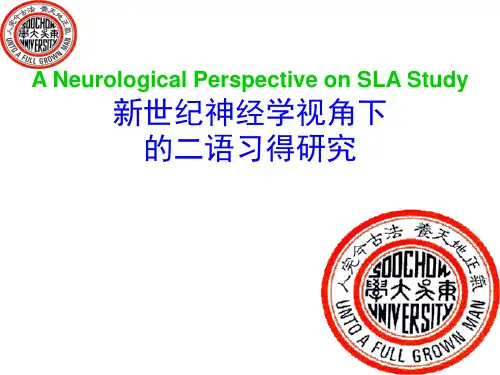

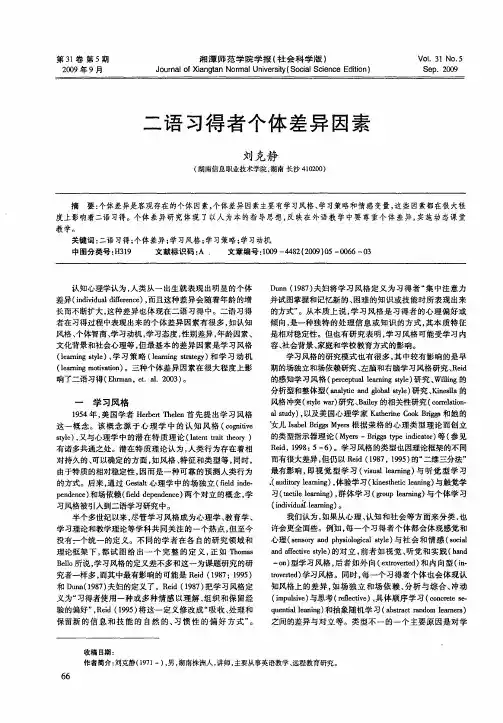
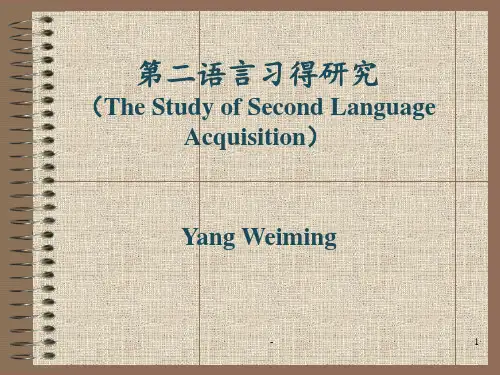

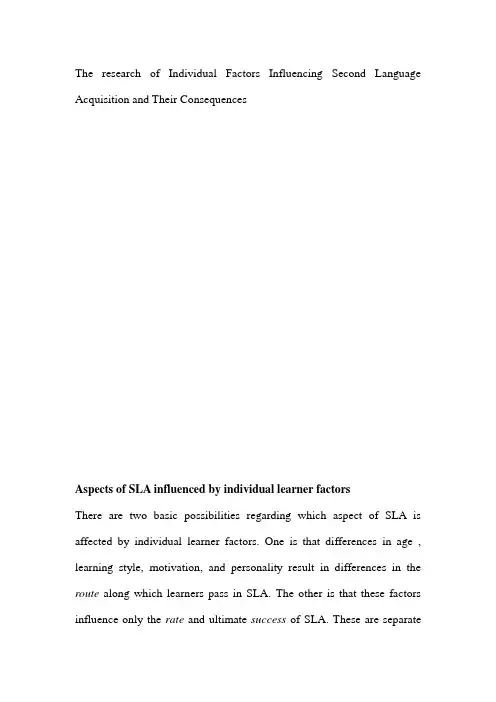
The research of Individual Factors Influencing Second Language Acquisition and Their ConsequencesAspects of SLA influenced by individual learner factorsThere are two basic possibilities regarding which aspect of SLA is affected by individual learner factors. One is that differences in age , learning style, motivation, and personality result in differences in the route along which learners pass in SLA. The other is that these factors influence only the rate and ultimate success of SLA. These are separateissues. To claim that individuals vary in the rate at which they learn or the level of competence they eventually attain is not controversial. Indeed it is part of most language learners’ and teachers’ experience.However, to claim that individual differences influence the sequence or order in which linguistic knowledge is acquired is far more controversial. It runs counter to the arguments and evidence in favour of the ‘natural’route of development.Aa will be seen in the discussion of each individual learner factor, the effect on the route of SLA has not been seriously investigated. Nearly all the research into learner variables has involved either investigating their effect on the proficiency levels achieved by different learners, or describing how they affected an individual learner’s response to the task of learning a L2. Neither proficiency nor learning response provides any insights about the route of acquisition.There are stark disagreements about the role of individual differences in SLA. As fillmore (1979) points out, on the one hand individual differences are seen as an all-important factor, which on the other hand they are treated as relatively insignificant. Research which has concentrated on accounting for differences in the proficiency levels of learners has tended to emphasize the importance of individual learner factors. Research which has tried to examine the process of SLA has tended to play down their importance.Identification and classification of learner factorsThe Identification and classification of the different individual factors has proved to be problematic. The main difficulty is that it is not possible to observe directly qualities such as aptitude, motivation or anxiety. These are merely labels for clusters of behaviors and, not surprisingly, different researchers have these labels to describe different sets of behavioral traits. As a result, it is not easy to compare and evaluate the results of their investigations. It is, therefore, not surprising to find that a host of terms have been employed to describe the phenomenona hawkey(1982)lists some of these : ‘affective, congnitive, and social factors’(tucker et al.1976), ‘affective and ability factors’(Chastain 1975),and ‘attitudinal /motivational characteristics’(gardner et al.1979).In an attempt to impose some order on this plethora of terms and concepts, I suppose to make an initial distinction between personal and general factors. Personal factors are highly idiosyncratic features of each individual’s approach to learning a L2. some examples are provided by Schumann and Schumann(1977) in a report of their own language learning experiences. They include ‘nesting patterns’(the need for a secure and orderly home base before learning can effectively begin), ‘transition anxiety’(the stress generated by moving to a foreign place), and the desire to maintain a personal language learning agenda. The Schumanns found that such factors strongly influenced their SLA. Thegeneral factors are variables that are characteristics of all learners. They differ not in whether they are present in a particular individual’s learning , but in the extent to which they are present , or the manner in which they are realized. General factors can be further divide into those that are modifiable (i.e. are likely to change during the course of SLA), such as motivation, and those that are unmodifiable (i.e. do not change in strength or nature as SLA takes place ) ,such as aptitude.Personal and general factors have social , cognitive, and affective aspects. Social aspects are external to the learner and concern the relationship between the learner and native speakers of the L2 and also between the learner and other speakers of his own language. Cognitive and affective factors aspects are internal to the learner. Cognitive factors concern the nature of the problem-solving strategies used by the learner, which affective factors concern the emotional responses aroused by the attempts to learn a L2. Different personal and general factors involve all three aspects in different degrees. Aptitude, for instance, is thought of a primarily cognitive in nature, but also involves affective and social aspects. Personality is primarily affective, but also has social an cognitive sides. Age is a factor that may involve all three aspects fairly equally. It is because the personal and general factors that make up an individual’s language learning style are composed of social, cognitive, and affective features that they are so complex, and, as a result, often rather vaguelydefined. Nevertheless, as the subsequent discussion will show, they play an important role in SLA.Personal factors are difficult to observe by a third person. This methodological problem has been solved in two ways. First, through the use of diary studies. The second solution to the methodological problem is to use questionnaires and interviews with individual learners, but there are so many difficulties in the course of collecting information about individual responses in this way. One is that subjects tend to say what they think the researcher wants to hear, or indulge in self-flattery. Another is that such techniques can reveal only those factors of which the learner is conscious. Nevertheless both the diary studies and the questionnaires/interviews have provided insights into the personal nature of language learning, particularly classroom language learning. Personal factors are by definition heterogeneous. However, they can be grouped together under three headings: (1) group dynamics,(2) attitudes to the teacher and course materials, and (3) individual learning techniques.Rod EllisUnderstanding second language acquisition 第二语言习得概论上海外语教育出版社99-126。
语言学习(二语习得)的个体差异(一)情感因素作为一个统括概念最先出现在美国南加州大学Krashen 的监控模式( the Monitor Model) 理论中, 该理论就语言习得提出了五大假说: 习得—学习假说( the Acquisition—Learning Hypothesis) ; 自然顺序假说( the Natural Order Hypothesis) ; 监控假说( the monitor Hypothesis) ; 输入假说( the Input Hypothesis) ;情感过滤假说( the Affective Filter Hypothesis) , 总结出语言习得与学习的区别, 以及影响语言学习的诸多因素。
在其情感过滤假说中, Krashen 率先将情感作为影响第二语言习得的一个重要因素单独罗列并加以探讨, 认为情感作为学习者内部的心理因素, 对语言输入有着过滤性作用, 该过滤作用直接制约着学习者接收输入的多少。
而且, 情感的过滤作用有大有小, 如果学习者的学习动力大, 自信心很强, 对第二语言的态度是积极的, 其学习情绪相对稳定, 那么情感对语言输入刺激的过滤作用就小, 学习者所获得的输入就越多; 相反, 则情感的过滤作用就大, 而学习者获得的输入就少。
依Krashen 的观点,这些作用对语言学习的影响无论大小, 都只是负面性的, 但同时它只影响语言发展的速度, 而不影响语言发展的道路。
这些情感因素包括学习的动机、对第二语言的态度、学习者的自信心与情绪等等。
对第二语言习得而言, 影响语言学习的情感因素则主要包括动机(motivation)、焦虑(anxiety)、自尊(self-esteem)、抑制(inhibition)、忍耐心( mind of endurance)、移情(empathy)、冒险心(mind of adventure)等等, 在语言学习中, 这些因素对语言学习者的影响并非孤立的, 它们往往相互交织, 共同作用于学习者的语言学习。